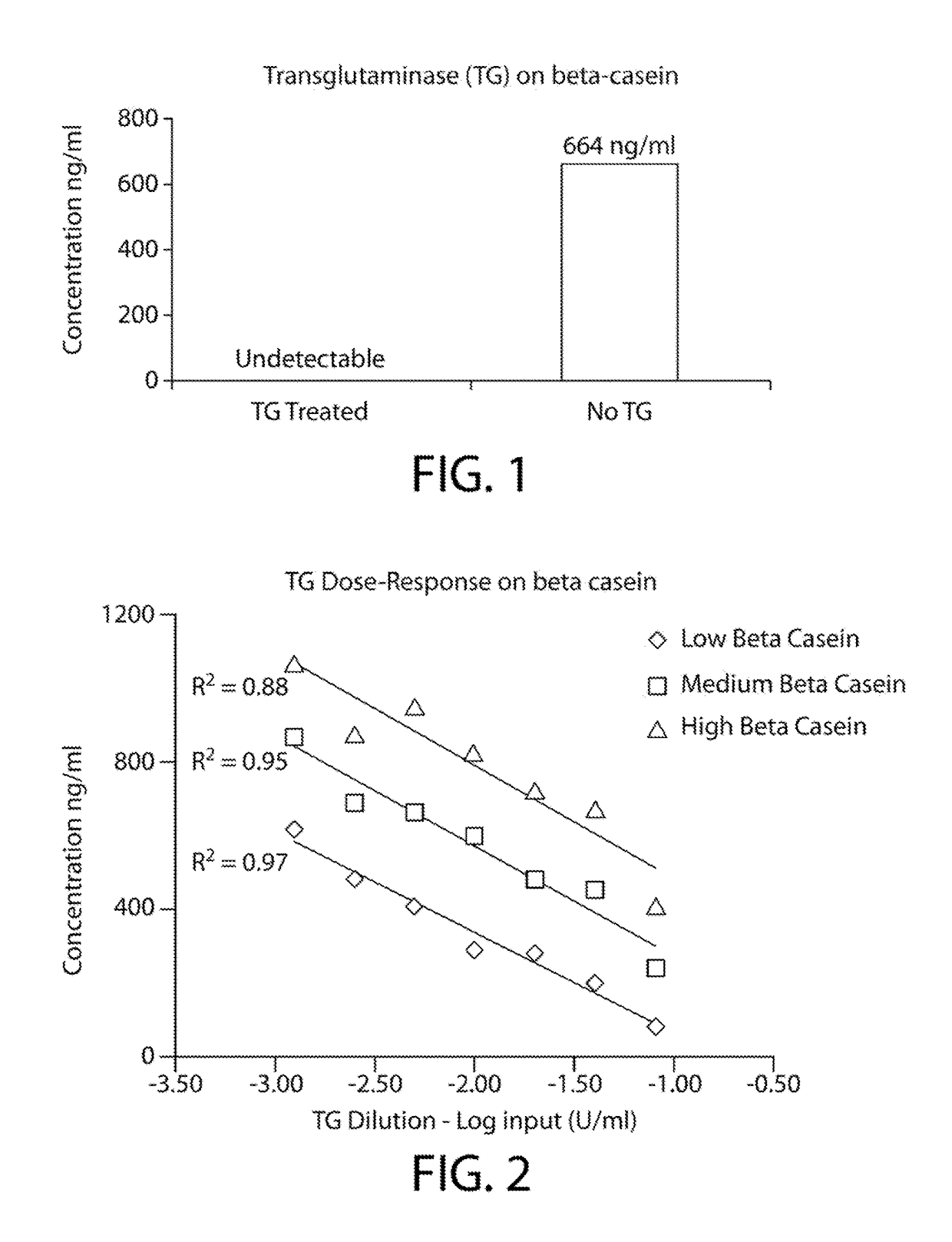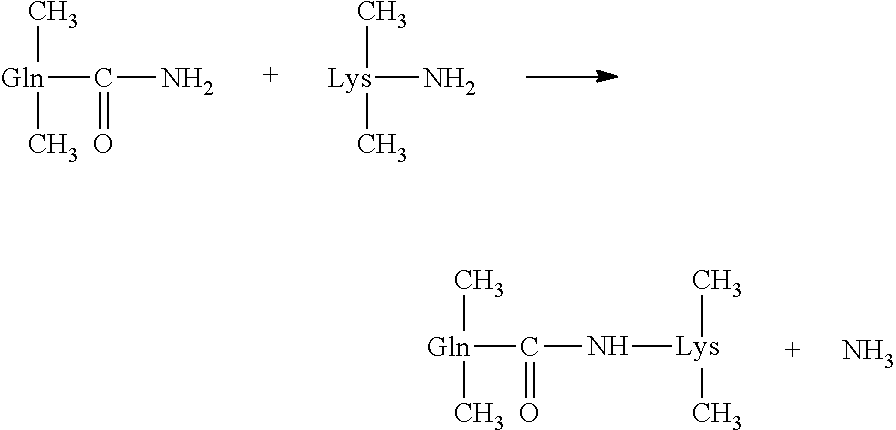Method and Compositions for Reducing Immunorecognition of Dietary Protein
a technology of immunorecognition and dietary protein, which is applied in the field of methods and compositions for reducing immunorecognition of dietary protein, can solve the problems of increasing food allergy incidence, not having effective treatment of food allergy, and not having the ability to prevent allergenic reactions, so as to reduce the immunoreactivity of a food
- Summary
- Abstract
- Description
- Claims
- Application Information
AI Technical Summary
Benefits of technology
Problems solved by technology
Method used
Image
Examples
example 1
Transglutaminase Treated β Casein
[0074]Purified β casein derived from milk was incubated with commercially available transglutaminase obtained from guinea pig liver (Sigma-Aldrich, St. Louis, Mo., Product No. T 5398) for two hours at 4° C. The reaction mixture was prepared as follows.
[0075]1) 100 μl 1 M Tris Acetate, pH 6.0
[0076]2) 50 μl 30 μg / ml β casein (derived from milk)
[0077]3) 10 μl 2 U / ml transglutaminase from guinea pig liver (Sigma-Aldrich, St. Louis, Mo.
[0078]4) 327.5 μl water
[0079]5) 2.5 μl of 1 M CaCl2 (added last)
[0080]Three distinct levels of purified β casein (low, medium and high) were also prepared and incubated with 0.08-00125 units of the transglutaminase. All transglutaminase-treated β casein samples were assayed using a double antibody sandwich ELISA for bovine casein detection according to the kit manufacturer's instructions (MyBioSource.com, Catalog #MBS564001).
[0081]FIG. 1 demonstrates that the purified transglutaminase enzyme was capable of decreasing the im...
example 2
Transglutaminase Treated Milk
[0083]2% milk samples were also prepared as described in Example 1, above, except that 50 μl of 2% milk diluted to 1000× with phosphate buffered salime 0.01 mol / L PBS(PH=7.0-7.2) replaced the purified β-casein as a substrate for the transglutaminase. The solution was incubated for 24 hours at 4° C. The transglutaminase treated 2% milk was also assayed by the double antibody sandwich ELISA described above.
[0084]FIG. 3 shows that the transglutaminase reaction is also effective in the intact 2% milk food matrix, which contains fat, carbohydrate, minerals and vitamins as well as proteins in addition to casein (e.g. β-lactoglobulin, α-lactoglobulin, bovine serum albumin). As shown in Table 1, above, even in the presence of the food matrix, transglutaminase was able to reduce the level of immunoreactivity of the casein by 85% (mean relative casein level of 1 in the absence of transglutaminase, 0.15 in the presence of transglutaminase).
example 3
Transglutaminase and Microbial Fermentation
[0085]A third trial was carried out by first reacting 2% milk with transglutaminase MooGloo® TI (Modernist Pantry) for 24 hours at 4° C. in an orbital shaker followed by microbial fermentation for 48 hours at 22° C. 900 μl 2% milk were combined with 40 mg MooGloo® TI, which is a mixture of transglutaminase and maltodextrin.
[0086]100 μl of a starter culture (2.5 g of starter culture in 10 ml of distilled water) containing Leuconostoc mesenteroides, Lactobacillus plantarum and Pediococcus acidilactici (Caldwell, Quebec City, Canada) was added to the reaction mixture described above. The fermentation mixture was incubated for 48 hours at 22° C. in an orbital shaker. After fermentation, casein was assayed using a competitive ELISA (Casein ELISA Kit, Astoria, Poncarale, Italy).
[0087]FIG. 4 and Table 3 show that the addition of microbial fermentation to the transglutaminase treatment of milk decreases milk immunoreactivity in the ELISA in a syner...
PUM
| Property | Measurement | Unit |
|---|---|---|
| temperature | aaaaa | aaaaa |
| temperature | aaaaa | aaaaa |
| molecular weight | aaaaa | aaaaa |
Abstract
Description
Claims
Application Information
 Login to View More
Login to View More - R&D
- Intellectual Property
- Life Sciences
- Materials
- Tech Scout
- Unparalleled Data Quality
- Higher Quality Content
- 60% Fewer Hallucinations
Browse by: Latest US Patents, China's latest patents, Technical Efficacy Thesaurus, Application Domain, Technology Topic, Popular Technical Reports.
© 2025 PatSnap. All rights reserved.Legal|Privacy policy|Modern Slavery Act Transparency Statement|Sitemap|About US| Contact US: help@patsnap.com



